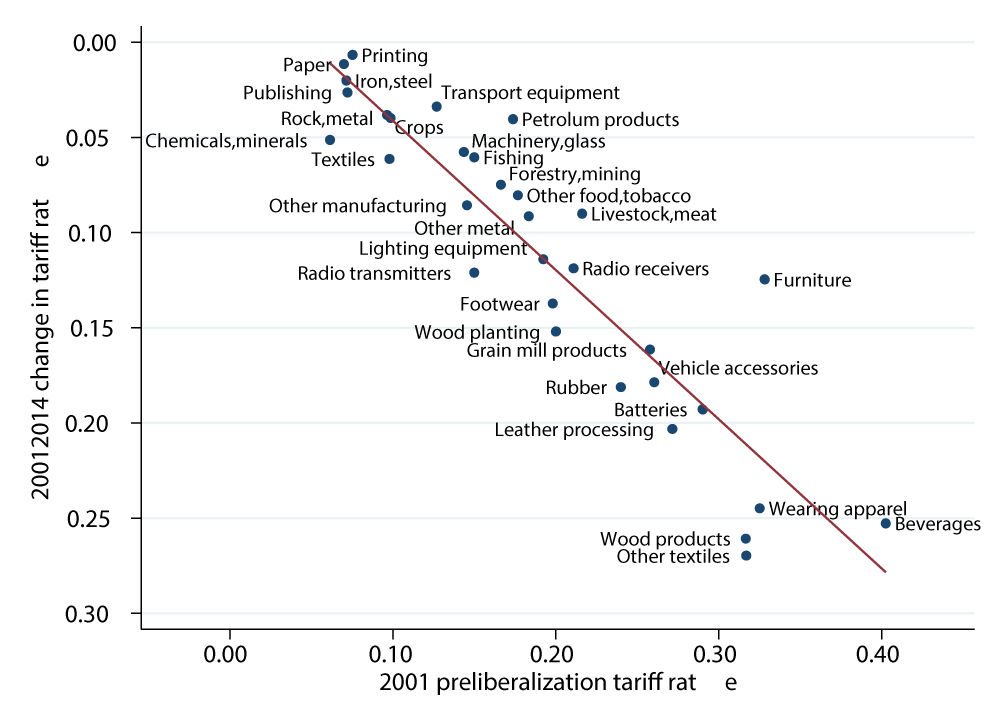Over the last three decades, the dramatic rise in global economic integration and rapid pace of trade liberalisation has had substantial effects across the developing world. A large body of empirical work documents that greater exposure to import competition adversely affects local labour market outcomes, leading to job losses and earnings decline (Pavcnik 2017, Dix-Carneiro and Kovak 2019). These trade-induced job losses were also shown to increase the incidence of violent crime by lowering the opportunity cost of criminal employment, reducing public-goods provision, and increasing income inequality (Dix-Carneiro et al. 2018, Dell et al. 2019). Moreover, the labour market effects of trade liberalisation differ for men and women due to sectoral differences in their initial employment rates (Gaddis and Pieters 2017).
Despite the growing evidence on the violent consequences of import competition and the evidence that trade-induced job losses vary by gender, previous studies mostly neglected potential effects of trade liberalisation on intimate partner violence experienced by women.
Trade liberalisation may affect the risk of intimate partner violence in several ways. If higher import competition leads to more job losses for men than for women, the narrowing of the gender employment gap could increase the bargaining power of women, raise their outside options, and reduce their exposure to domestic violence (Aizer 2010, Anderberg et al. 2016). However, the same reduction in the gender employment gap could also increase men’s incentives to use violence to control decision-making in the household, extract resources from women, or force women to work longer hours (Eswaran and Malhotra 2011, Bobonis et al. 2013, Erten and Keskin 2018, 2021a). Moreover, import competition may also widen the gender employment gap if women disproportionately lose their jobs relative to men, which may lead to opposite effects through these channels.
In Erten and Keskin (2021b), we study the effects of trade-induced employment changes on intimate partner violence by focusing on the local labour-demand shocks brought about by the Cambodian trade liberalisation episode. In 2004, Cambodia became a member of the World Trade Organization (WTO), and in doing so, it implemented large-scale unilateral trade liberalisation.
Figure 1 shows that the average nominal tariffs fell from nearly 18% in 2001 to 8% in 2014. Moreover, as can be seen in Figure 2, the industries with the highest tariff levels prior to liberalisation experienced the greatest tariff reductions. The differential tariff reductions across industries were primarily the outcome of Cambodia’s WTO negotiations, excluding the possibility of discretionary changes to the tariff structure.
Figure 1 Average nominal tariff rates
Notes: This graph plots the unweighted average of nominal tariff rates over time for Cambodia. The average is constructed at the 3-digit industrial classification level. Tariff data are obtained from the WITS–TRAINS database.
Figure 2 Tariff reductions and pre-liberalisation tariff rates by sector
Notes: This graph shows the total reduction in tariffs between 2001 and 2014 observed by subsector relative to the pre-liberalisation tariff rate observed in 2001. Correlation: -0.912; regression coefficient: -0.780; standard error: 0.063; t: –12.35. Tariff data are obtained from the WITS–TRAINS database.
We use detailed industrial employment data from the 1998 Census, which are representative at the district level, to construct a measure of exposure to tariff reductions at the district level. Comparing districts that were more exposed to tariff declines due to their initial industry mix to districts that were less affected, we assess how changes in the employment of women relative to men affected the risk of intimate partner violence.
Our findings show that men initially employed in districts facing larger tariff reductions experienced a significant relative decline in paid employment. In contrast, women employed in harder-hit districts increased their relative entry into the labour force. In particular, women who were previously outside the labour force began to contribute to family income by working additional hours in family-owned enterprises. These findings suggest an added worker effect, in which a reduction in the employment probability of men induces more women to participate in the labour market to compensate for the income loss experienced by their partners.
Next, we link trade-induced employment changes to the prevalence of intimate partner violence. Using several rounds of the Demographic and Health Surveys of Cambodia, we find that women in districts more exposed to trade liberalisation experienced a relative increase in physical violence, sexual violence, and psychological violence. Moreover, they reported a higher likelihood of physical injuries due to violence from their partners, including bruises, broken bones, and other forms of physical injuries, while their decision-making power declined. Exploring alternative mechanisms, our estimates show no evidence of differential changes in marriage rates, fertility, psychological distress, or husbands’ behavioural indicators in these districts.
Overall, these findings are consistent with instrumental theories of violence, which predict the use of violence by men as an instrument for controlling household decision-making, appropriating resources from women, or forcing them to work more, which is, in a sense, another form of resource extraction. In this context, we have conducted additional analysis to show that intimate partner violence is used as a tool to force women to work, particularly as unpaid workers in family enterprises.
Our study contributes to a growing international trade literature that documents the effects of trade liberalisation on a range of health and economic outcomes, including mortality and marriage market outcomes (Autor et al. 2019, Pierce and Schott 2020), self-reported health assessments (Lang et al. 2019, Adda and Fawaz 2021), labour market outcomes (Dix-Carneiro and Kovak 2019, Branstetter et al. 2019, Keller and Utar 2020), crime (Dell et al. 2019, Dix-Carneiro et al. 2018), and local public goods provision (Feler and Senses 2017). Our analysis adds to a broader understanding of distributional consequences of trade liberalisation by focusing on an outcome—intimate partner violence—that has not been previously studied in the trade literature.
More generally, our findings have broader implications for the distributional consequences of trade policy. In cases where trade openness brings about changes in male–female employment gaps, these employment changes are likely to have significant effects on intrahousehold bargaining dynamics. In many contexts where exposure to import competition results in greater job losses for men than women, such increases in the relative employment of women are likely to generate important changes in the prevalence of intimate partner violence. In fact, neglecting such potentially large backlash effects from increased intimate partner violence may yield upward-biased estimates of the societal benefits accruing from trade liberalisation.
References
Adda, J, and Y Fawaz (2021), “The health toll of import competition”, VoxEU.org, 9 March.
Aizer, A (2010), “The gender wage gap and domestic violence”, American Economic Review 100(4): 1847–59.
Anderberg, D, H Rainer, J Wadsworth and T Wilson (2016), “Unemployment and domestic violence: Theory and evidence”, Economic Journal 126(597): 1947–79.
Autor, D, D Dorn and G Hanson (2019), “When work disappears: Manufacturing decline and the falling marriage market value of young men”, American Economic Review: Insights 1(2): 161–78.
Bobonis, G J, M Gonzalez-Brenes and R Castro (2013), “Public transfers and domestic violence: The roles of private information and spousal control”, American Economic Journal: Economic Policy 5(1): 179–205.
Branstetter, L, and B Kovak, J Mauro and A Venâncio (2019), “The China Shock and employment in Portuguese firms: The role of labour market regulations”, VoxEU.org, 1 December.
Dell, M, B Feigenberg and K Teshima (2019), “The violent consequences of trade-induced worker displacement in Mexico”, American Economic Review: Insights 1(1): 43–58.
Dix-Carneiro, R, and B K Kovak (2019), “Margins of labor market adjustment to trade”, Journal of International Economics 117: 125–42.
Dix-Carneiro, R, R R Soares and G Ulyssea (2018), “Economic shocks and crime: Evidence from the Brazilian trade liberalization”, American Economic Journal: Applied Economics 10(4): 158–95.
Erten, B, and P Keskin (2018), “For better or for worse? Education and the prevalence of domestic violence in Turkey”, American Economic Journal: Applied Economics 10(1): 64–105.
Erten, B, and P Keskin (2021a), “Trade-offs? The impact of WTO accession on intimate partner violence in Cambodia”, Review of Economics and Statistics, forthcoming.
Erten, B, and P Keskin (2021b), “Female employment and intimate partner violence: Evidence from Syrian refugee inflows to Turkey”, Journal of Development Economics 150: 102607.
Eswaran, M, and N Malhotra (2011), “Domestic violence and women’s autonomy in developing countries: Theory and evidence”, Canadian Journal of Economics 44(4): 1222–63.
Feler, L, and M Z Senses (2017), “Trade shocks and the provision of local public goods”, American Economic Journal: Economic Policy 9(4): 101–43.
Gaddis, I, and J Pieters (2017), “The gendered labor market impacts of trade liberalization evidence from Brazil”, Journal of Human Resources 52(2): 457–90.
Keller, W, and H Utar (2020), “‘Biological clocks’, import competition, and the gender gap in earnings”, VoxEU.org, 5 March.
Lang, M, T Clay McManus and G Schaur (2019), “The effects of import competition on health in the local economy”, Health Economics 28(1): 44–56.
Pavcnik, N (2017), “The impact of trade on inequality in developing countries”, NBER Working Paper No. 23878.
Pierce, J R, and P K Schott (2020), “Trade liberalization and mortality: Evidence from US counties”, American Economic Review: Insights 2: 47–64.





